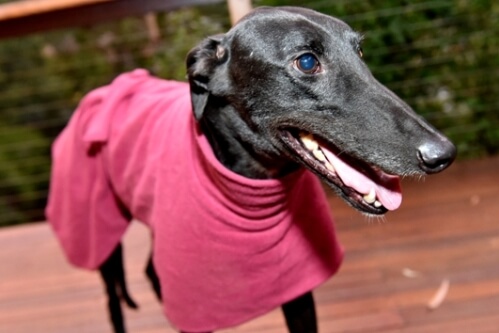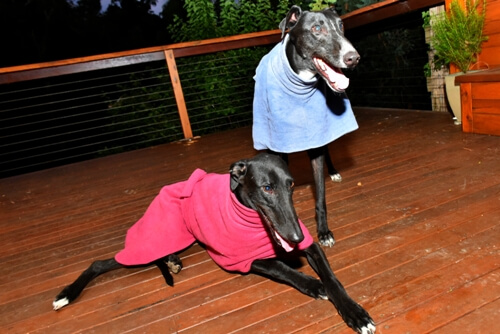Background
Greyhounds have relatively thin skin and very little body fat. This is great for helping them cool down after a run, but it also means that they are susceptible to cold weather. The need to maintain their vital organs at a fairly constant temperature means that the body has to work harder during the winter to keep warm. This can affect diet and potentially cause injury when exercising.
If the greyhound’s core temperature drops, its body automatically tries to keep the important organs warm by restricting the blood flow to the skin and extremities. You will have experienced cold fingers and hands on a very brisk morning, along with the exposed skin that’s cool to the touch and which turns bluish. This same process happens in greyhounds to try to conserve heat when the outside temperature is low.
If this is not enough to maintain the core temperature, the body will try to generate heat by shivering, which is an involuntary muscle activity. Shivering is an indicator of significant temperature change within the body, and it uses up quite a bit of energy to create the muscle contractions.
Past this point the dog enters into hypothermia (hypo– meaning ‘below’, –thermia meaning ‘temperature’).
For the greyhound, being cold is not only uncomfortable, but it can mean that they lose condition due to the change in their energy requirements. Now they not only have to fuel their normal activity but also have to use energy to create warmth just to function normally on the inside. This may mean they need more calories in their daily diet.
Cold muscles are also more susceptible to injuries, ranging from minor tears to more serious ones.

What can you do?
Make sure that your greyhounds are kept warm when the weather is cold.
For greyhounds that sleep outside, a bed that is well off the cold ground, and making sure that your kennel building is not leaking or subject to draughts.
Make sure that each dog has a clean and dry kennel to sleep in. Winter weather does not make it easy to keep things clean and dry, but wet dogs, wet bedding, and wet kennels can lead to very cold greyhounds.
You might need to put a warm coat or jacket on the dogs, especially in the evenings and overnight. Make sure that coats are regularly inspected for damage, and are not tied on so tight that they are uncomfortable when the greyhound curls up, nor so loose that the dogs are constantly getting tangled in them. All coats and jackets should be regularly cleaned too – male dogs are notorious for peeing on the edges of their coats!

Watch your dog’s weight
It may be that your greyhounds will need more food to maintain their weight in the winter time. Monitoring skin and coat condition and body weight will quickly tell you if something isn’t right. Keeping them warm may not completely stop changes in condition, but it will help.
By paying attention to your greyhounds needs during winter, you will save yourself time and money and avoid injuries and illness.
For more information about Greyhound Care and Standards, click here.


